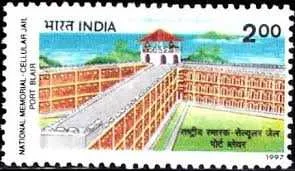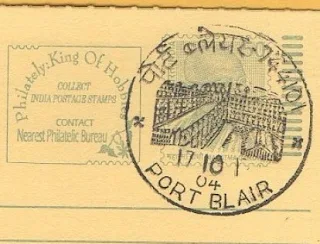The Cellular Jail, also known as Kālā Pānī (Hindi for black waters), was a colonial prison in the Andaman and Nicobar Islands, India. The prison was used by the British for the express purpose of exiling political prisoners to the remote archipelago. Many notable independence activists, including Batukeshwar Dutt, Yogendra Shukla, and Vinayak Damodar Savarkar were imprisoned here during the struggle for India's independence. Today, the complex serves as a national memorial monument.
Although the prison complex itself was constructed between 1896 and 1906, the British had been using the Andaman Islands as a prison since the days in the immediate aftermath of the revolt of 1857.
Shortly after the rebellion was suppressed, the British executed many rebels. Those who survived were exiled for life to the Andamans to prevent their re-offending. Two hundred rebels were transported to the islands under the custody of the jailer David Barry and Major James Pattison Walker, a military doctor who had been warden of the prison at Agra. Another 733 from Karachi arrived in April, 1868.In 1863, the Rev. Henry Fisher Corbyn, of the Bengal Ecclesiastical Establishment, was also sent out there and he set up the 'Andamanese Home' there, which was also a repressive institution albeit disguised as a charitable one.Rev. Corbyn was posted in 1866 as Vicar to St. Luke's Church, Abbottabad, and later died there and is buried at the Old Christian Cemetery, Abbottabad. More prisoners arrived from India and Burma as the settlement grew.
The remote islands were considered to be a suitable place to punish the independence activists. Not only were they isolated from the mainland, the overseas journey (kala pani) to the islands also threatened them with loss of caste, resulting in social exclusion.[6] The convicts could also be used in chain gangs to construct prisons, buildings and harbour facilities.
By the late 19th century the independence movement had picked up momentum. As a result, the number of prisoners being sent to the Andamans grew and the need for a high-security prison was felt. From August 1889 Charles James Lyall served as home secretary in the Raj government, and was also tasked with an investigation of the penal settlement at Port Blair.He and A. S. Lethbridge, a surgeon in the British administration, concluded that the punishment of transportation to the Andaman Islands was failing to achieve the purpose intended and that indeed criminals preferred to go there rather than be incarcerated in Indian jails. Lyall and Lethbridge recommended that a "penal stage" should exist in the transportation sentence, whereby transported prisoners were subjected to a period of harsh treatment upon arrival. The outcome was the construction of the Cellular Jail, which has been described as "a place of exclusion and isolation within a more broadly constituted remote penal space."
The construction of the prison started in 1896 and was completed in 1906. The original building was a puce-coloured brick building.The building had seven wings, at the center of which a tower served as the intersection and was used by guards to keep watch on the inmates; this format was based on Jeremy Bentham's idea of the Panopticon. The wings radiated from the tower in straight lines, much like the spokes of a bicycle wheel.
Each of the seven wings had three stories upon completion. There were no dormitories and a total of 696 cells. Each cell was 4.5 by 2.7 metres (14.8 ft × 8.9 ft) in size with a ventilator located at a height of 3 metres (9.8 ft).[10] The name, "cellular jail", derived from the solitary cells which prevented any prisoner from communicating with any other.[citation needed] Also, the spokes were so designed such that the face of a cell in a spoke saw the back of cells in another spoke. This way, communication between prisoners was impossible. They were all in solitary confinement. The locks of the prison cells were designed in such a way that the inmate would never be able to reach the latch of the lock. The prison guards would lock up the inmates and throw the key of the lock inside the jail. The inmate would try to put his hand out and try to unlock the door but would never be able to do so as his hand would never reach the lock.
Most prisoners of the Cellular Jail were independence activists. Some inmates were Fazl-e-Haq Khairabadi, Yogendra Shukla, Batukeshwar Dutt, Babarao Savarkar, Vinayak Damodar Savarkar, Sachindra Nath Sanyal, Bhai Parmanand, Sohan Singh, Subodh Roy and Trailokyanath Chakravarty.
🔟 Top 10 Trivia Facts About Cellular Jail
- Location: Port Blair, Andaman and Nicobar Islands
- Construction Period: 1896 to 1906
- Meaning of Kala Pani: "Black Waters" indicating exile
- Prison Design: 7 wings for maximum isolation
- Total Cells: 693 solitary cells
- Famous Inmates: Veer Savarkar, Batukeshwar Dutt
- Declared Memorial: 1979
- Main Attraction: Light and Sound Show
- Used for: Exiling political prisoners during British rule
- Now a Museum: Attracts thousands of visitors annually


